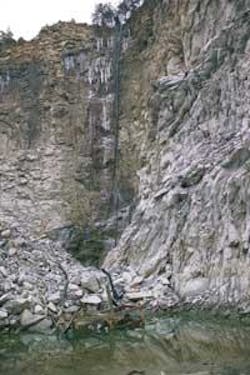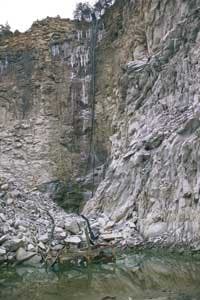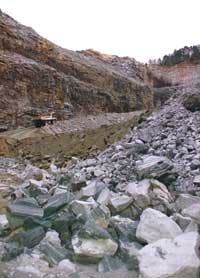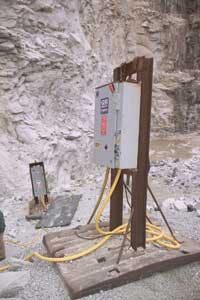Oconee County Quarry Pumped Up Over Submersible Pumps
Oconee County Quarry, outside of Walhalla, SC, is a county-owned rock quarry, providing more than 2,500 tons of a variety of crushed rock daily for county needs as well as those of contractors and the general public. If rainwater and runoff from nearby springs are allowed to collect in the quarry, operations slow or even stop - making water removal a constant necessity.
Since digging began in 1979, Oconee County had relied on a single Gorman-Rupp S4D1 10-HP submersible electric pump to keep the water out the bottom of the quarry. In heavy rains, the quarry utilized two side-by-side pumps to keep the water at a manageable level and the digging operation ongoing.
At the time, the pumps were initially placed at the quarry’s lowest point, a natural gathering area for water. The walls were 75-feet high and a 10-HP pump was adequate to drive water out of the site. Water was pumped up the side of the quarry through a 4-inch line and sent another 50 feet to a retaining pond on county grounds. As the quarry grew deeper, the walls climbed higher. After 20 years, the two 10-HP pumps were still strong tools, but the distance, now over 200 feet, was affecting the rate of water withdrawal and thus the level of water in the quarry.
Quarry foreman Mickey Kerr found that the pumps were straining to pump water the additional distance. “The older pumps were still working well, but the effectiveness of pumping the water up the steeper walls was not as strong as it had been in the past due to the added vertical distance,” said Kerr.
Quarry technicians were pleased with the performance of the original 10-HP pump, so they turned to Gorman-Rupp to provide a solution for their ever-deepening rock quarry. With their experience with the existing pump and additional research, Kerr knew he could count on these pumps to hold up to the rigors of a dusty, hard and constantly changing quarry.
“As we went deeper into this quarry, we had to step up our pump size to get the task accomplished,” said Kerr. “To get the job done right, we decided on a pair of Gorman-Rupp’s 65-HP electric pumps to replace the two 10-HP pumps.”
The pumps, located in the customer’s pit in a sump hole at the base of now a 200-foot-high wall, are both attached to float switches that power up the pumps when the water reaches a certain level. The 65-HP S-Series pumps easily transmit water the 300 feet total distance, with over 200-feet straight up the wall. Furthermore, bigger pumps have benefited the county by pumping more water out of the quarry, lowering the customer’s overall operating costs and allowing them to dig deeper without having to invest in additional pumps in the near future.
Kerr selected electric pumps to allow water to be pumped any time of the day or night, and to reallocate a worker responsible for refueling the diesel engines.
“Being a county-owned entity, we had to stay within a budget, while also finding the most effective manner in which to keep the water at a low level. The electric pumps best suited our needs. More water is now pumped faster than ever before.”
The majority of the water is sent to a retaining pond on county property, but Kerr also uses the water for several applications.
“In a mining situation, having a water truck is a must. We fill the truck with water daily and continually spray water on the roads leading into and out of the quarry to keep the dust to a minimum. We are also in the process of filtering the water in order to use it to cool the oil pumps that are used in our rock crushing operation.”
Today, 18 Oconee County employees are involved in the quarry operation to handle any problems and keep this county enterprise efficient.
“Another reason we chose these pumps is the service we’ve gotten from our distributor, Interstate Equipment,” Kerr said. “Interstate has helped us get more than 15 years of operation from our first 10-HP pump and they are very attentive when it comes to getting parts or service for all of the pumps used here at the quarry. Interstate also helped train our staff to obtain the most out of the new 65-HP pumps for years to come.” IWW
Based in Mansfield, Ohio, The Gorman-Rupp Company manufactures pumps and pumping systems for the municipal, water, wastewater, sewage, industrial, construction, petroleum, fire and original equipment manufacturing markets. Established in 1933, its products include self-priming centrifugal, centrifugal, submersible, trash, priming assist, rotary gear and air-driven diaphragm pumps - as well as packaged lift and booster stations. Contact: 419-755-1011 or [email protected].



